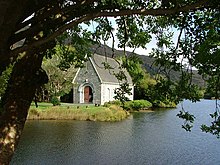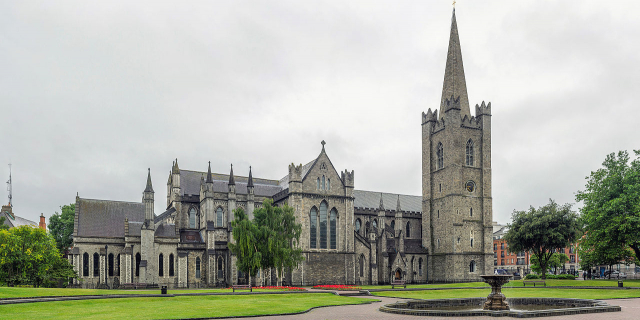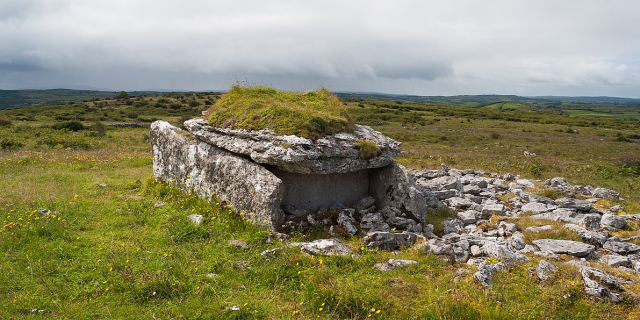Saint Fin Barre's Cathedral (Irish: Ardeaglais Naomh Fionnbarra) is a Gothic Revival three-spire Church of Ireland cathedral in the city of Cork. It is located on the south bank of the River Lee and dedicated to Finbarr of Cork, patron saint of the city. Formerly the sole cathedral of the Diocese of Cork, it is now one of three co-cathedrals in the United Dioceses of Cork, Cloyne and Ross in the ecclesiastical province of Dublin. Christian use of the site dates back 7th-century AD when, according to local lore, Finbarr of Cork founded a monastery. The original building survived until the 12th century, when it either fell into disuse or was destroyed during the Norman invasion of Ireland. Around 1536, during the Protestant Reformation, the cathedral became part of the established church, later known as the Church of Ireland. The previous building was constructed in the 1730s, but was widely regarded as plain and featureless.
...Read more
Saint Fin Barre's Cathedral (Irish: Ardeaglais Naomh Fionnbarra) is a Gothic Revival three-spire Church of Ireland cathedral in the city of Cork. It is located on the south bank of the River Lee and dedicated to Finbarr of Cork, patron saint of the city. Formerly the sole cathedral of the Diocese of Cork, it is now one of three co-cathedrals in the United Dioceses of Cork, Cloyne and Ross in the ecclesiastical province of Dublin. Christian use of the site dates back 7th-century AD when, according to local lore, Finbarr of Cork founded a monastery. The original building survived until the 12th century, when it either fell into disuse or was destroyed during the Norman invasion of Ireland. Around 1536, during the Protestant Reformation, the cathedral became part of the established church, later known as the Church of Ireland. The previous building was constructed in the 1730s, but was widely regarded as plain and featureless.
The cathedral's demolition and rebuild was commissioned in the mid-19th century by an Anglican church intent on strengthening its hand after the reforms of penal law. Work began in 1863, and resulted in the first major commissioned project for the Victorian architect William Burges, who designed most of the cathedral's architecture, sculpture, stained glass, mosaics and interior furniture. Saint Fin Barre's foundation stone was laid in 1865. The cathedral was consecrated in 1870 and the limestone spires completed by October 1879.
Saint Fin Barre's is mostly built from local stone sourced from Little Island and Fermoy. The exterior is capped by three spires: two on the west front and one above the nave, at the crossing with the transept. Many of the external sculptures, including the gargoyles, were modelled by Thomas Nicholls. The entrances contain figures of over a dozen biblical characters, surmounted by a tympanum showing a Resurrection scene.
 Modern church at Gougane Barra
Modern church at Gougane Barra A map of Cork in the early 18th century, featuring "The Cathedral" (D)
A map of Cork in the early 18th century, featuring "The Cathedral" (D)The church grounds are south of the River Lee on Holy Island, on one of the many inlets forming the Great Marsh of Munster (Corcach Mor na Mumhan). Saint Fin Barre's is on the site of at least two previous church buildings, each dedicated to Fin Barre of Cork, patron saint of Cork city and founder of the monastic hermitage at Gougane Barra.[1]
Finbarr was born in about 550. He was, by legend, given Gougane Barra as a place of contemplation, and visited Cork city to lay the foundation stones for the "one true Christian faith".[2] According to tradition, after Finbarr died his remains were brought to Cork to be enclosed in a shrine near the site of today's cathedral.[3]
Archaeological evidence suggests the first site at Fin Barre's probably dates from the 7th century, and consisted of a church and round tower[4] that survived until the 12th century, after which it fell into neglect, or was destroyed during the Norman invasions.[5]
Medieval and 18th-century churches Photograph of the early stage of the construction, c. 1865
Photograph of the early stage of the construction, c. 1865A 1644 reference to the site notes that "in one of the suburbs of Korq [Cork] there is an old tower ten or twelve feet [3.3 m] in circumference, and more than one hundred feet [30 m] high ... believ[ed] to have been built by St. Baril [Finbarr]".[6] The building was badly damaged in 1690 during the siege of Cork, after which only the steeple remained intact, due to an outbreak of fire and the impact of a 24-pound (11-kg) shot[7] from Elizabeth Fort in nearby Barrack Street. The cannonball was rediscovered during the 1865 demolition and is now on display in the cathedral.[8] The church was demolished in 1735[9] and replaced the same year by a smaller building, as part of a citywide phase of construction and renovation.[10]
Only the earlier spire was retained for the new building.[11] The older part of this church was described in 1862 as Doric in style, attached to a featureless modern tower with an "ill-formed" spire.[12] The building was widely considered to be poorly designed. The Dublin Builder called it "a shabby apology for a cathedral which has long disgraced Cork",[13] while The Parliamentary Gazetteer of Ireland judged it "a plain, massive, dull, tasteless, oblong pile, totally destitute of what is usually regarded as cathedral character, and possessing hardly a claim to any sort of architectural consideration".[14] It was demolished in 1865.[15]
19th-century building Gargoyle
Gargoyle Gargoyle
Gargoyle Gargoyle
GargoyleIn April 1862, the Church of Ireland, in pursuit of a larger, more attractive cathedral, and determined to reassert its authority in response to resurgent Catholicism,[16] initiated a competition for a replacement building,[17] which became the commission for the first cathedral to be built in the British Isles since London's St Paul's.[17] The next February, the designs of the architect William Burges, then 35,[18] were declared the winner of the competition.[19] Burges disregarded the £15,000 budget, producing a design that he estimated would cost twice as much.[17] Despite the protestations of fellow competitors, it won.[20] His diary records his reaction—"Got Cork!"—while cathedral accounts mention a payment of £100 as prize money.[19] The foundation stone was laid on 12 January 1865,[17] the unfinished cathedral consecrated in 1870 by Bishop John Gregg,[19] and the spires topped out in 1879,[20] though minor work continued on the cathedral for many years afterward.[21]
Burges used a number of his earlier unrealised designs for the exterior, including those intended for the Crimea Memorial Church, Istanbul, St John's Cathedral, Brisbane and elevations for Lille Cathedral.[22] The main obstacle was economics. Despite the efforts of fundraisers, Cork was unable to afford a large cathedral.[23] Burges partially alleviated this by designing a three-spired exterior that enhanced the size of the building to viewers.[23] He realised early on the build would vastly exceed the money the city had raised.[13]
The superiority of his design was recognised by Gregg, who supported Burges and lobbied for additional funding.[24] Gregg was instrumental in sourcing additional money, including local merchants such as William Crawford of the Crawford brewing family and Francis Wise, a local distiller.[7] The final total was significantly over £100,000. Assured by Gregg's efforts, Burges was unconcerned.[25] Gregg died before the completion of the project. In his place, his son Robert continued his father's support, and in 1879 ceremoniously placed the final stone on the eastern spire. By then the contractors estimated that the build was nearing its completion, with only a number of pre-designed stained glass fittings left to be installed.[17]
[In the future] the whole affair will be on its trial and, the elements of time and cost being forgotten, the result only will be looked at. The great questions will then be, first, is this work beautiful and, secondly, have those to whom it was entrusted, done it with all their heart and all their ability.[25]
January 1877 letter from Burges to Gregg
The cathedral holds the book of estimates prepared for the decoration of the west front. Nicholls was paid £1,769 for the modelling, and Robert McLeod £5,153 for the carving. Burges took 10 per cent for the design, more than his usual 5 per cent, apparently due to his high level of personal involvement.[26] Its construction took seven years before the first service was held in 1870. During the first building phase, three firms of contractors were employed, owned by, chronologically, Robert Walker, Gilbert Cockburn and John Delany, who completed the spires' construction in 1879.[7] Building, carving and decoration continued into the 20th century, long after Burges's death in 1881,[19] including the marble panelling of the aisles, the installation of the reredos and side choir walls, and the 1915 construction of the chapter house.[27]
The architectural historians David Lawrence and Ann Wilson call Saint Fin Barre's "undoubtedly [Burges's] greatest work in ecclesiastical architecture",[19] with an "overwhelming and intoxicating" interior.[28] Through his ability, careful leadership of his team, artistic control, and by vastly exceeding the intended budget, Burges produced a building that—though not much larger than a parish church—has been called "a cathedral becoming such a city and one which posterity may regard as a monument to the Almighty's praise".[29]
20th and 21st centuries Southern side in winter
Southern side in winterMindful that the cathedral was unlikely to be finished in his lifetime, Burges produced comprehensive plans for its decoration and furnishing, recorded in his Book of Furniture and Book of Designs.[30] At the end of the 20th century, a major restoration of the cathedral, costing £5 million, was undertaken.[31] This included the reinstatement and restoration of the twin trumpets held by the resurrection angel which had been vandalised in 1999.[31] The restoration programme also saw the cleaning, repointing and repair of the exterior of the building, including the re-carving of some of Burges's gargoyles, where repair proved impracticable.[32] The cathedral's heating system was also replaced when it was found to be damaging the intricate mosaic floor.[33]
In 2006, Lawrence and Wilson published the first detailed study of the cathedral's history and architecture, The Cathedral of Saint Fin Barre at Cork: William Burges in Ireland.[34] The building is also covered in Frank Keohane's volume Cork: City and County, in the Buildings of Ireland series, published in 2020.[35] The cathedral is one of the three cathedrals of the Anglican Diocese of Cork, Cloyne and Ross, the other two being Saint Colmán's Cathedral in Cloyne, and Saint Fachtna's Cathedral in Rosscarbery.[36]
Notable interments in the graveyard include those of archbishop William Lyon (died 1617), Richard Boyle (died 1644),[37] and, in a family vault, the first "Lady Freemason", Elizabeth Aldworth (died c. 1773–1775).[38]






























Add new comment